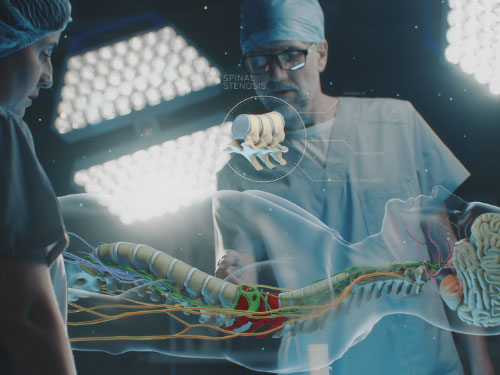
Advancing human health with augmented reality – the future is now
From guiding ERs in the field to giving surgeons hands-free visual overlays during surgery, augmented reality is transforming the way healthcare professionals work.
In 2020, a team of surgeons from John Hopkins University made the news. Their patient, a 78-year-old man, had degenerative spine disease. The surgeons needed to place critical, life-saving implants and, just like other spinal surgeries, precision and accuracy were imperative. Because of the proximity to the spinal canal and surrounding vessels, misplacing a single screw would lead to disastrous complications. What made this surgery newsworthy is that the doctors performed the surgery using a head-mounted augmented reality (AR) display from Augmedics. During the operation, the AR headset allowed the specialists to visualise the patient’s CT scan and, as a result, place the implants with 100% accuracy. Fast forward five years, Augmedics has already treated over 5 000 patients with its FDA-approved Xvision Spine System.
This extraordinary lifestyle-enhancing procedure may have marked the start of AR in the operating room but for the healthcare industry, AR has been used to enhance medical training for a number of years. AR, like virtual reality (VR), is an extended reality tool, but unlike VR, which takes you to a different space, AR places the digital content you need in your field of view – in real time. It merges the physical with the digital. This could mean wearing a head-mounted display like the Apple Vision Pro and smart glasses. These devices, which were at one time only used for entertainment purposes, have moved into other sectors with incredible results. in real time. It merges the physical with the digital. This could mean wearing a head-mounted display like the Apple Vision Pro and smart glasses. These devices, which were at one time only used for entertainment purposes, have moved into other sectors with incredible results.
Transformative vision
In simple terms, AR can give you the right information, when it’s needed, while your hands remain free. For a doctor, this means greater efficiency, accuracy, personalisation, and overall better therapeutic outcomes. Sometimes, in surgery, a doctor needs to make a diagnosis in the heat of the moment. While this decision is more instinctive than impulsive (as it relies on previous experience and patient knowledge) the choice can now also be data-driven, drawing information from huge medical datasets using artificial intelligence (AI). This could range from which surgical instrument will work best to overlaying digital images onto the patient’s anatomy. Surgeons will no longer have to turn away to look at separate monitors or other displays if the critical information they require is directly in front of them. Prior to surgery, AR technology can be used to create virtual models of the patient’s anatomy, based on medical imaging scans. Surgeons can then simulate the procedure in a virtual environment, practicing the steps and refining their approach before entering the operating room.
Beyond the operating room, AR is transforming patient care. A nurse, for example, is often required to draw blood or hang an IV bag. Vascular access is one of the most common invasive medical procedures. Doctors need blood results, but many people are afraid of needles. With AR, accurate vein detection is possible because nurses (and other medical professionals like phlebotomists or locums) can be guided with – step-by-step details in the form of superimposed visuals that are easy to follow – on site. And those patients with small or difficult-to-find veins won’t be subjected to unnecessary needles. Right now, there is an option of using a handheld ultrasound machine to find veins, but AR smart glasses or headgear leaves two hands free.
Is there a doctor here?
Another interesting case study for AR is the rescue AED (automated external defibrillator) kit used by emergency responders. Although today’s AED kits are relatively easy to use with voice prompts and images for visual guidance, an AR-enhanced AED kit that includes a headset or smart glasses could make the rescue process even more efficient and effective. The practice of lifesaving interventions in Emergency Medical Response Services (EMRS) is greatly enhanced by the ability to stabilise and treat a patient en route, while simultaneously relaying data points of the patient status from electrocardiogram (ECG) placement in field of view. The patient’s visual condition can also be monitored and viewed up to the handover point. This approach provides a comprehensive view of the patient’s situation, significantly reducing the time compared to traditional methods. By allowing paramedics to focus on hands-on patient care rather than filling out patient record forms, this integrated system improves efficiency and patient outcomes.s visual condition can also be monitored and viewed up to the handover point. This approach provides a comprehensive view of the patient’s situation, significantly reducing the time compared to traditional methods. By allowing paramedics to focus on hands-on patient care rather than filling out patient record forms, this integrated system improves efficiency and patient outcomes.
From the surgeons-in-training using AR simulators to practice surgical techniques in a realistic, risk-free environment, to remote experts who, through video streaming and AR overlays, can virtually ‘step into’ the operating room, there’s no question that AR has already transformed the way healthcare professionals operate and it will continue to gain traction. In fact, according to Research and Markets, the worldwide AR market is expected to reach over $289 billion by 2030. The number of startups launching innovative AR solutions for the industry is growing at a rapid pace, with MedTech companies like EchoPixel, MediView and Augmedics leading the charge. In the coming decade, these organisations are poised to transform healthcare delivery by pushing the boundaries of AR innovation in patient care, surgical precision, and more.










